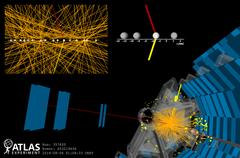Event in the ATLAS detector, in which a pair of W bosons is created when two photons collide. These then decay into a muon and an electron (visible in the detector) and neutrinos (not detected) (Image: CERN / ATLAS Collaboration).
The international ATLAS collaboration at CERN's LHC have presented the first observation of a new, very rare type of event in its detector during the International Conference on High Energy Physics (ICHEP 2020) which is currently taking place. Collisions of two photons - the carriers of the electromagnetic force - produced pairs of W bosons. These elementary particles are mediators of the weak force, another of the four fundamental forces.
This is not the first time that the international group of researchers has been able to observe collisions between particles of light in the ATLAS detector, but so far no pairs of other force particles have come out of these collisions. The new results, in which DESY researchers play a major role, confirm one of the most important predictions of the electroweak theory, namely that force-carrying particles – the W boson, the Z boson and the photon – interact not only with ordinary particles of matter but also with each other.
"Our PhD student Filip Nechansky has made significant contributions to data analysis. Together with a team, Filip carried out detailed underground studies and their corrections, which are necessary to extract such extremely rare particle processes," said Thorsten Kuhl, scientific member of the DESY ATLAS group and Nechansky's PhD supervisor. At the conference, the data were presented by Mateusz Dyndal from CERN, who was already significantly involved in the analysis of the first light-light collisions in ATLAS during his time as postdoc at DESY.
The data presented also point the way to a new way of using the LHC, namely as a high-energy photon-photon collider. With such collisions, the electroweak interactions can be studied in more detail, thus testing the Standard Model of particle physics and searching for new phenomena to better understand our universe.








